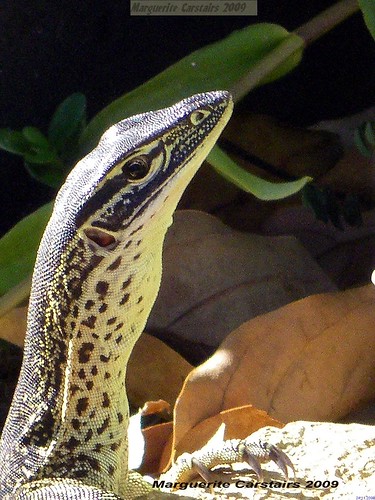He lives in the Caravan Park.
I was sitting outside reading a book, when a scratching sound realised a small goanna crawling through the fallen leaves from under my Unit.
He walked across the road to the lusher garden opposite and sat on a rock and surveyed the world before retiring to the green
The goanna ('go-anna') is an Australian reptile that is also known as the monitor lizard. Some species of goanna can grow up to 2 m (around 6 ft) long.
Goanna
is the name given to any of the various Australian monitor lizards of the genus Varanus, as well as to certain species from Southeast Asia.
There are around 20 species of goanna, 15 of which are endemic to Australia. They are a varied group of carnivorous reptiles that range greatly in size and fill several ecological niches. The Goanna features prominently in Aboriginal mythology and Australian folklore. Traditionally, it formed an important part the diet of many Aboriginal peoples.
Being predatory lizards, goannas are often quite large, or at least bulky, with sharp teeth and claws. The largest is the Perentie (Varanus giganteus), which can grow over 2m in length. Goannas prey on all manner of small animals; insects, lizards, snakes, mammals, birds, eggs.
Most goannas are dark in coloration, whites, greys, blacks and greens featuring prominently. Many desert dwelling species also feature yellow-red tones. Camouflage ranges from bands and stripes to splotches, speckles and circles, and can change as the creature matures; juveniles sometimes being brighter than adults.
Like most lizards, goannas lay eggs. Most lay eggs in a nest or burrow, but some species lay their eggs inside termite mounds. This offers protection and incubation, additionally the termites may provide a meal for the young as they hatch. Unlike other species of lizards, goannas do not have the ability to regrow limbs or tails.
http://www.walkaboutpark.com.au/index.php?id=228
Goannas (aranus gouldii) have flat bodies, long necks, big claws, well-developed teeth and forked tongues and they make very good bush tucker.
Twenty of the world's 30 monitor species are found in Australia. Goannas are carnivorous and live off insects and small animals and love to eat eggs. They usually walk around on all fours, but will rise up on their back legs to defend themselves from attackers.


140x45.jpg)




No comments:
Post a Comment